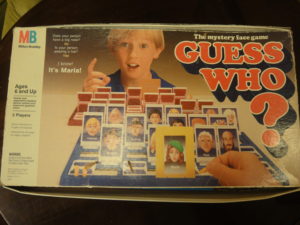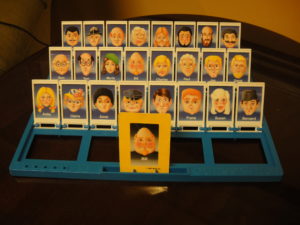My Guess Who game has seen so much activity over the years the box top hardly qualifies as a cover anymore. I think it has two sides and the top left.
But I doubt many therapists who have stumbled upon this game would be surprised, because it’s awesome!
It’s fun. It’s engaging. You get to smack those little hinged doors down on every turn. And it’s amazing for working on:
- Descriptive concepts: short/long, big/small, colors
- Asking questions: “Does your person________?” or “Is your person__________?”
- Answering yes/no questions: “Yes. My person_________.” Or “No. My person________?”
- Vocabulary building: blond (I always hear “yellow hair” and I’ve spent too much on mine to tolerate it being called “yellow”); rosy (vs. red) cheeks; facial hair/mustache/beard; and get creative—it’s not a small nose, it’s tiny, miniscule or petite.
- Articulation: And, of course, it’s ideal for articulation carry-over activities since there is so much repetition. (is/does/person: guarantees s/z productions on every turn; your/person: guarantees r productions on every turn)
Haven’t played before? This is how it works. Each player has a board. Although you can play against the child, it’s almost better if you are the moderator for two children playing against each other. That way you can “see” both boards and help answer or prompt questions. You may also need to assist with the sometimes confusing concept of which doors are shut down.
Each player randomly chooses a card (person) which is kept secret from the other player. The object of the game is to guess who your opponent is before they guess who you are! On your turn, you ask a yes/no question to narrow down who they might be.
Examples: “Is your person a boy?”
“Does your person have blond hair?”
“Does your person have facial hair?”
“Does your person wear a hat?”
“Does your person have rosy cheeks?”
Based on your opponent’s answer you will need to close down those possibilities that don’t fit. Hence the confusion.
Question: “Does your person have brown eyes?”
Answer: “Yes.”
This means all blue-eyed possibilities are put down—and that’s where lots of kids are baffled. If you are playing against a child, you may need to say:
Answer: “Yes. My person has brown eyes. So…blue eyed people go down.”
A final tip? You may want to use some tape to reinforce the box sides!
Remember, all US subscribers (as of midnight October 18, 2011) are automatically entered in a drawing for Artic Attack! Don’t forget to sign up!








This Post Has 4 Comments
Great idea! I’ve also seen therapists insert picture cards they made themselves with pictures of the client’s family members, teachers, therapists, etc. Having the pictures of people they encounter in everyday life can be truly effective. Also, if your client is on the autism spectrum, you could create pictures that showcase various emotions and have them indicate if they are happy/sad/mad, etc.
What a FANTASTIC idea! It looks like there is also a travel version of the game with a field of 20 possibilities which might be easier if you were modifying it. Thanks for the input.
The newer version is even better because it has several different boards, expanding the vocabulary, descriptor and target phoneme possibilities. This game is a staple for me and my students love it.
Cheryl,I came across the “new” version on sale at Walmart about a month ago and picked it up. While I still feel very loyal to my original game, I do like the way the sheets slide in so easily and that there are more options on the new one. Thanks for sharing! Kim
Comments are closed.